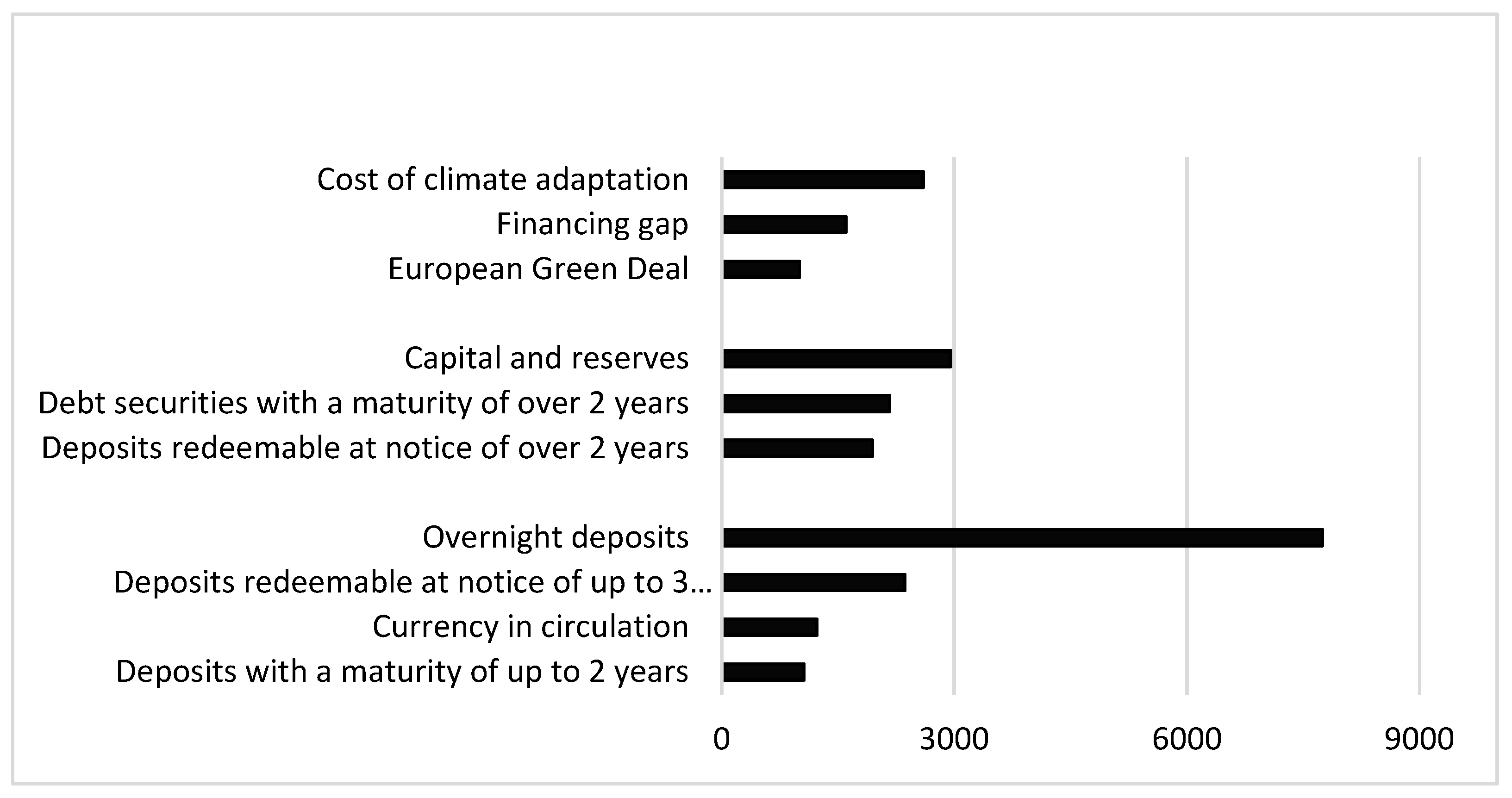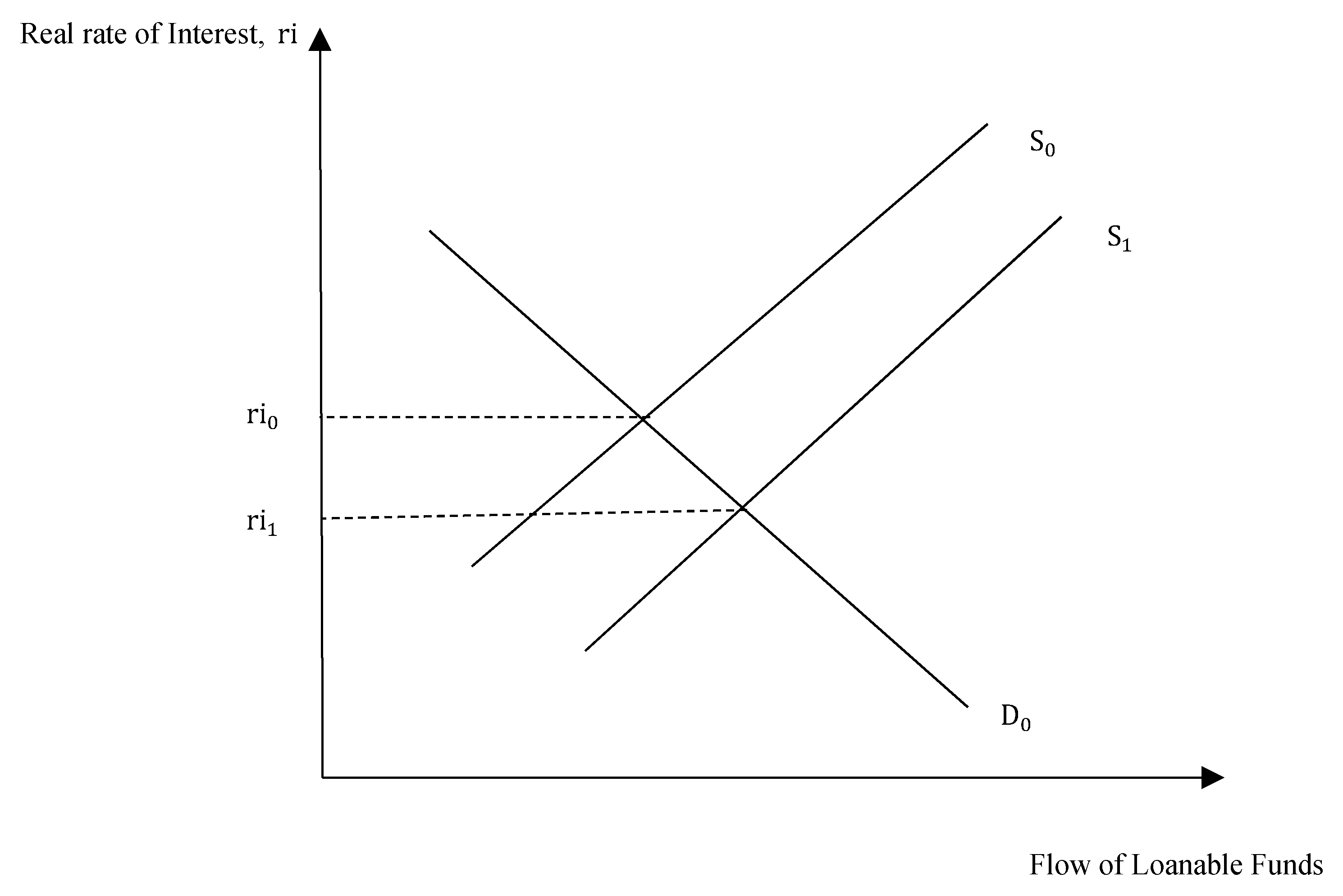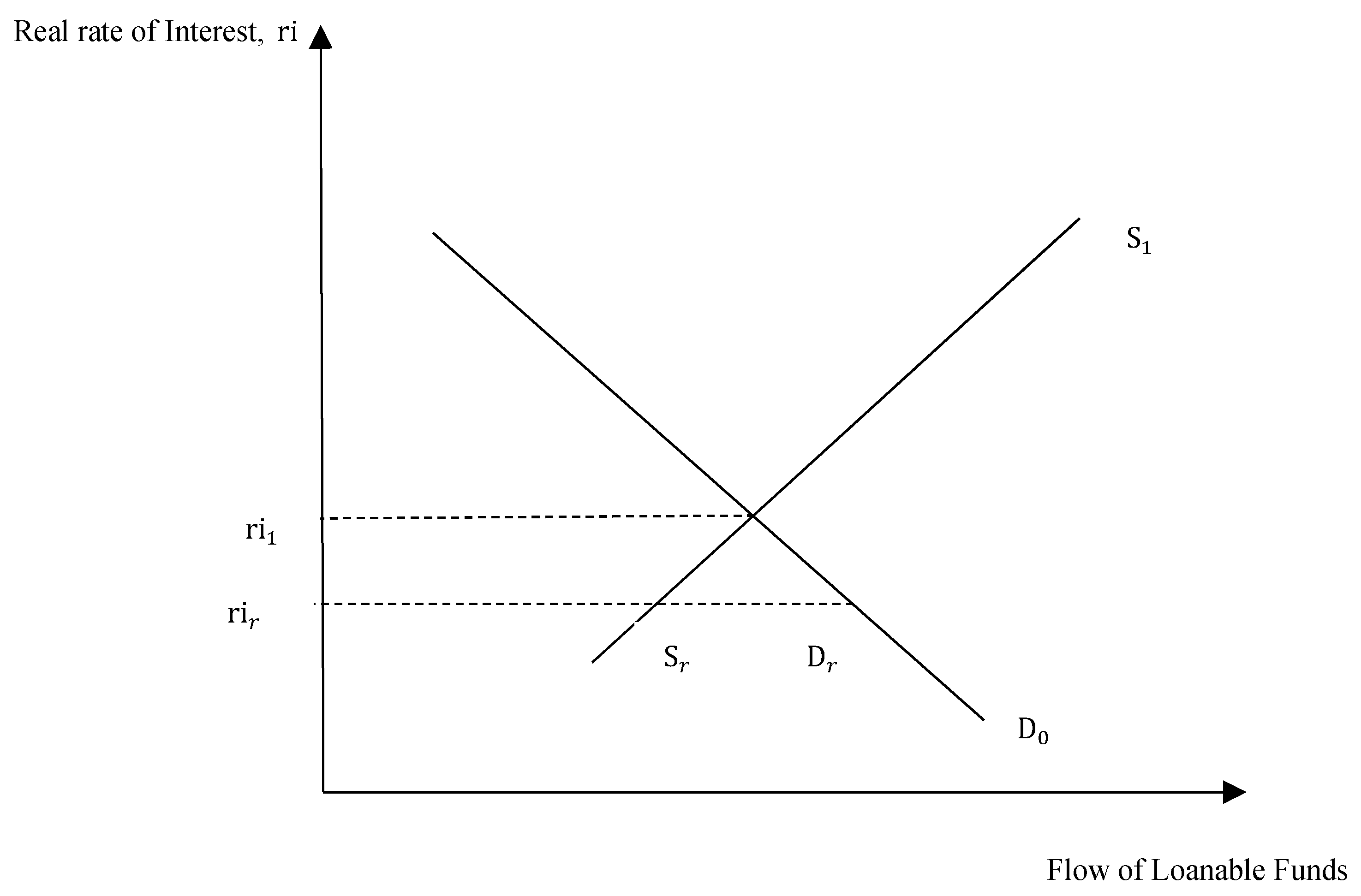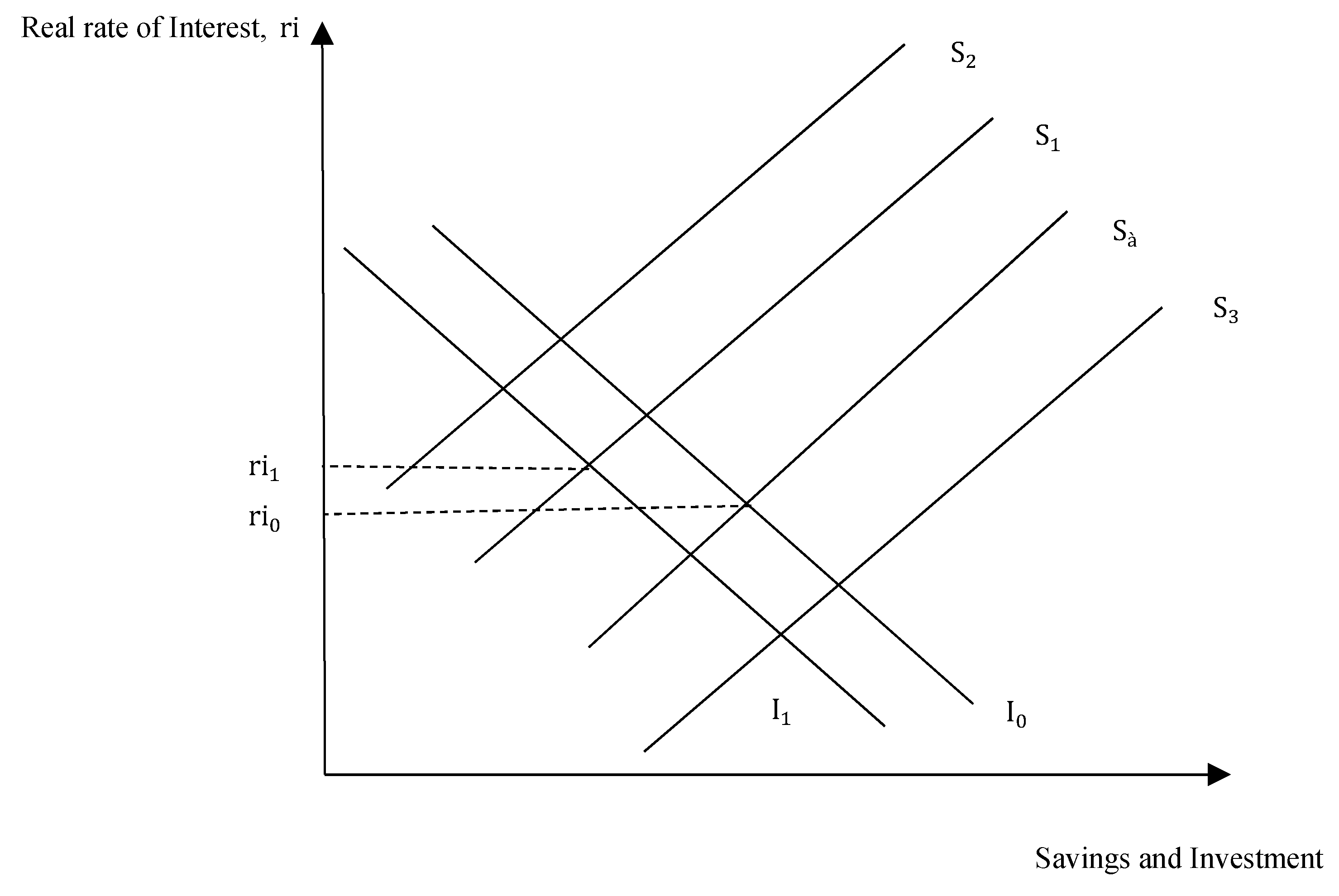4.1. A Transaction Flows Matrix
Following the seminal work of Godley and Lavoie [
19], we use a consistent theoretical and accounting framework to present an up-to-date explanation of the endogenous theory of money. We begin by realistically integrating the real and financial sector sides of a simplified economy using a transaction flows matrix (
Table 1). Each economic transaction in the matrix is double-sided, i.e., one’s income corresponds to another’s spending, and one’s asset is always another’s liability. Changes to the stock of assets and liabilities by each sector (in columns) result from its budget constraint, and the latter depends on flows of income and spending (in rows). Changes to each sector’s stock of assets and liabilities at the end of each period appear in the shaded area of
Table 1.
The coherence of the matrix, in which a (+) sign indicates a source of funds and a (-) sign indicates a use of funds, is built on double entry bookkeeping logic: each row and each column must sum to zero. At first glance, the matrix reveals that savings and investment appear, not as the determinants of the economic system, but rather as their twin determinates. For instance, positive household savings is a surplus of income over spending that materializes as assets appearing in the balance sheets of households, and as liabilities in the balance sheet of the issuing sector. Whether a given sector issues liabilities (or accumulates assets) at the end of each period, however, depends on a complex set of interrelated macroeconomic, behavioral, institutional factors, which determine the flow of transactions in a manner that is always consistent with accounting rules. The LFT conception of money as a “given stock,” which has no counterpart in the rest of the economy, hence appears meaningless.
The matrix comprises four sectors: the household sector, the production firm sector, the public sector (made of a government and its Central Bank), as well as a relatively sophisticated financial sector based on recent development in post-keynesian economics [
40]. The financial sector comprises banks and a “shadow-banking sector” comprising money market mutual funds, broker-dealers and special purpose vehicles. Macroeconomic income appears as a memo, in line with Equation (1): the excess of income over consumption (i.e., savings) cannot differ from the addition to investment.
Column 1 shows the budget constraint of households. Households receive various flows of income such as wages (W), dividend payments (from equity holdings in production firms (), banks (), and money market mutual funds ()), and interest on their banking deposits (). They spend their income on consumption (C), interest payments on their loans () and tax payments net of transfers (). Any surplus of income over spending adds to their stock of assets. The latter comprises cash (), bank deposits (), and equities, which are issued by banks (), production firms () and money market mutual funds (). Any excessive spending relative to income implies a decrease in assets or an increase in household debt ().
Column 2 shows the receipts and outlays of production firms in their current account. Firms receive payment flows on their sales of final goods (C) and capital goods (I), pay wages (W), taxes () and interest on their bank loans (). Column 3 shows that firms’ capital expenditures are financed via retained earnings (), new loans () or equity issues ().
Columns 4 to 8 describe a financial sector comprising banks and a simplified shadow banking system with money market mutual funds, broker-dealers and special purpose vehicles.
Columns 4 and 5 show the current account and the capital account of banks. Banks receive interest payments on loans (), on their T-bill holdings (), and pay interest on their clients’ deposits (). The difference constitutes their profit (), which is split between dividend payments () and retained earnings (). These retained earnings, along with the new deposits () and equity issues (), appear on the liability side of banks’ balance sheets. They are the counterpart to the assets owned by banks, which include granted loans (), high-powered money (cash and reserves) () and T-bills ().
Column 6 describes the money market mutual funds (MMMFs). MMMFs issue equities () in exchange for banking deposits (). They also hold Treasury bills (), which they purchase from broker-dealers in reverse repo operations. They distribute all their profits to households ().
Columns 7 and 8 describe broker-dealer (BD) entities and special purpose vehicles (SPVs), which are both subsidiaries of commercial banks. Broker-dealers hold T-bills ), which they sell to MMMFs in repo operations in exchange for banking deposits (), and hold MBS shares issued by special purpose vehicles . Special purpose vehicles issue mortgage-backed securities (MBSs) () and use the proceeds to purchase loans from the banks . Profits of broker-dealers and SPVs ( and ) are distributed back to the banking sector.
Column 9 describes the budget constraint of the government. It shows that any investment expenditure (
) that is not financed by taxes (
) (or by Central Bank dividends
) must be financed by an issue of T-bills (
). Following Godley and Lavoie [
19], in our matrix the interest on T-bills paid by the government to the Central Bank is returned to the government, so that net interest disbursement is:
.
Columns 10 and 11 represent the current account and the capital account of the Central Bank. The Central Bank owns T-bills () and its main liability is the high-powered money (cash and reserve currency) that it issues (). Any addition to the bond portfolio of the Central Bank must be accompanied by an increase in the amount of high-powered money. Central Bank profits (equal to the T-bill rate) are transferred to the government ().
4.2. Credit, Finance and Savings: the Endogenous Money Perspective
The transactions flow matrix shown in
Table 1 is a useful device with which to analyze the financing of the economy from an endogenous money perspective. This starts by acknowledging that private banks do not lend preexisting funds, but instead create new credit money every time they grant a loan [
15]. There are, of course limits to the power of banks to create money. Banks must meet profitability constraints in order to remain competitive and must ensure that the firm has a capacity to repay. They must also abide by prudential regulations, in particular capital requirements. Finally, banks must be able to acquire reserves at a low cost if the firm wants to spend its deposits. Therefore, even though banks can create unlimited amounts of deposits, they have no incentive to do so because it may expose them to both insolvency and illiquidity risks. Examining the actual functioning of a banking system shows, nonetheless, that the causality relationship does not run from savings to investment (as indicated by the LFT) but, in fact, in the opposite direction.
We may illustrate this through the simplest case, where a bank extends a loan to a firm that wishes to extend its production capacity.
Table 2 accordingly focuses on the relevant entries in the transaction matrix. It shows that credit creation entails four balance sheet entries: a new deposit enters the bank’s balance sheet on the liability side and the borrower’s balance sheet as an asset; and a new loan, which enters the bank’s balance sheet as an asset and the borrower’s balance sheet as a liability As opposed to popular belief, there is no ex-ante intermediation when a bank grants a loan, since both sides of the balance sheet (the loan/the deposit) involve the same client [
41].
As soon as the firm undertakes investment by spending its new deposits on wages (W), macroeconomic income increases (in line with Equation (1)). New deposits are transferred to the bank account of the households providing the goods and services to the firm. These deposits are income not spent—which means, at an accounting level, that savings go up. Of course, the loan’s counterpart is the saver’s deposit, but there should be no confusion regarding causality: the loan is financed by an ex-nihilo money creation [
40] The bank can be thought of as an “ex-post” intermediary [
38,
42].
As households provide labor in exchange for the salaries, firms accumulate inventories, which appear on their capital account (I) as the ex-post counterpart of the bank loan. Finally, households spend a part of their income on consumption (C). This allows firms to retrieve their money balances and to repay the initial bank loan. At this point, the credit money, which allowed production in the first place, is destroyed, as the bank’s balance sheet shrinks on both sides. This mechanism is fully consistent with Equations (2) and (3): following an increase in investment, income will increase to a level that makes the change in savings equal to the change in investment.
The conclusions of the LFT are therefore turned upside down. At the macroeconomic level, net accumulation of savings necessitates a preliminary increase in debt-financed investment (and not the other way around).
Denis [
43] offers an even simpler demonstration. Letting W represent the wage bill, S represents household savings, and I represents firms’ net investment in a given year, the economy’s sale of final goods is equal to household consumption (W-S) plus net investment (I). Firm profits π are, in turn, equal to the difference between sales (W-S+I) and the wage bill W, i.e., π =I-S. Profits thus correspond to the share of firms’ net investment
which is not financed by savings.
In the post-Keynesian view, finance and savings are therefore two very different things. Finance is a flow of credit determined on the basis of entrepreneurial expectations, while savings are a residual stock caused in the first place by macroeconomic dynamics. This has practical implications exactly opposed to those implied by the LFT. In particular, increase in savings by the household sector (a “thrift campaign”) does not result in increased investment. Instead, it implies a direct loss of income for production firms (as consumption spending (C) decreases). This loss is unlikely to trigger new investment plans. It is more likely to lead to the formation of pessimistic entrepreneurial expectations, which reduces the investment rate and, ultimately, the accumulation of financial wealth —i.e., savings—at the next period.
These basic observations are by no means new, and have been known at least since the work of Keynes (1936). The fact that they seem to have been forgotten by most financial economists—outside of the post-Keynesian tradition—has led certain authors to conclude that we live in a “
dark age of macroeconomics” [
44].
4.3. Incorporating “Shadow Banking” into the Analysis
The development of the so-called “shadow banking system” (also called “non-bank finance” or “market based” finance) is an important feature of the modern economy (Lagoarde-Segot, 2015). In the endogenous money perspective, shadow banking does not provide additional financing to the economy, but adds layers of debts within the financial sector, based on a pre-existing stock of banking deposits. As indicated in [
40] (p. 17): “The raw materials used by the shadow banking system to produce securities are created by traditional banks, so the former cannot expand if the latter does not grow in the first place.”
Assume for instance that households decide to rebalance their portfolio and buy shares issued by the money market mutual fund (MMMF). A fraction of banking deposits
(which were created, in the first place, through production credit, as in
Table 2), are then transferred from the household’s account to the MMMF’s account in exchange for shares
). These deposits still appear on the liability side of the banking sector’s balance sheet. This situation is shown in
Table 3 below.
The MMMF then enters into a reverse repurchase agreement with a broker-dealer. The broker-dealer sells a T-bill to the MMMF (
), agreeing to repurchase it at a future date. As shown in
Table 4, the banking deposits now appear on the asset side of the broker-dealer’s balance sheet.
This situation does not last very long, as the broker-dealer uses these acquired deposits to purchase MBSs issued by a special purpose vehicle (
Table 5).
The SPV, in turn, uses the deposits to buy packages of loans from the commercial bank. As a result, the bank moves the loans off its balance sheet, which destroys a corresponding amount of credit money (
Table 6).
In summary, the shadow banking system entails the issuing of a chain of liabilities (ownership rights and a portfolio of pre-existing loans (MBSs)) against an initial flow of banking deposits. This scheme permits banks to move loans out of their balance sheet, and gives them incentive to finance riskier projects. In the endogenous money perspective, the shadow banking system adds layering, complexity, and fragility to the financial system without altering the fundamental macroeconomic causality running from credit to deposits and from investment to savings. Quoting Keynes, “the investment market can become congested through a shortage of cash. It can never become congested through a shortage of savings” [
37] (p. 222). The next section attempts to carve out policy responses to the sustainable finance gap using endogenous money theory as a conceptual framework.










